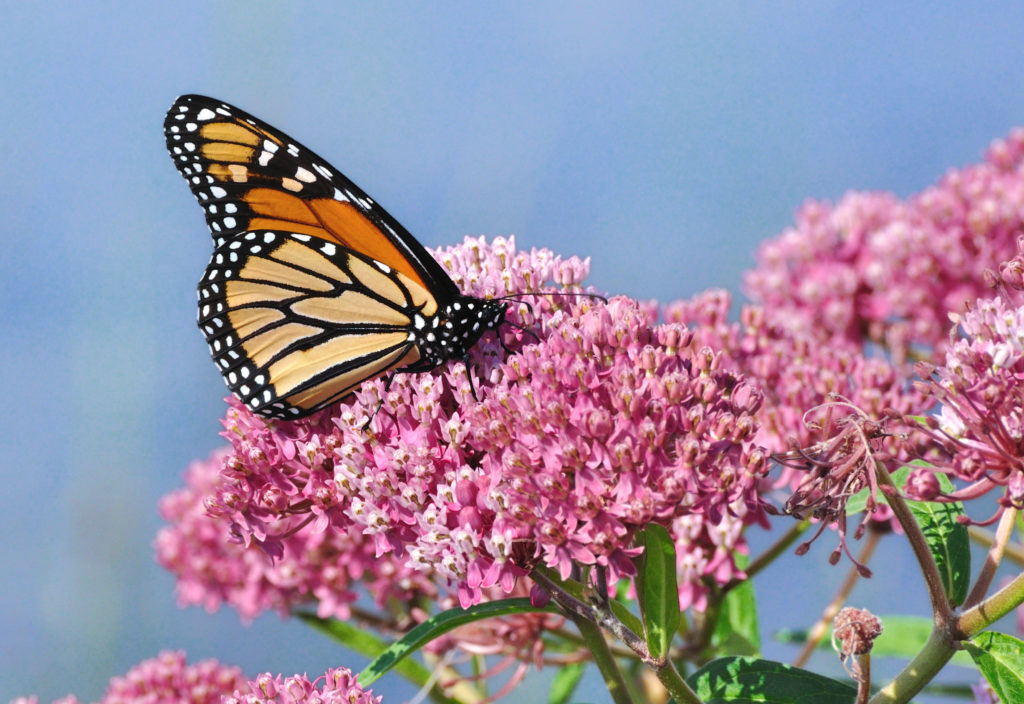A group of utilities are developing a plan to enhance monarch butterfly habitat on their transmission line rights-of-way by adjusting vegetation management practices. “EPRI research on the causes of the monarch’s decline and potential solutions is helping to inform the utilities that are involved in developing the monarch plan,” said Tim Lohner, PhD consulting environmental specialist at American Electric Power (AEP).
Monarch butterflies spend their winters in fir forests on a dozen mountaintops in central Mexico, their colorful wings turning the trees orange. They make their way north, many toward the Great Lakes, to breed in the spring and summer.
But this familiar North American species is in trouble: Almost a billion strong in the mid-1990s, the population has declined by more than 80%. Researchers believe that one cause is the loss of milkweed, the prairie plant species on which monarchs feed and breed. Other possible factors include loss of winter habitat in Mexico and California and pesticide use. By June 30, 2019, the U.S. Fish and Wildlife Service is expected to decide whether to list monarch butterflies as endangered or threatened under the federal Endangered Species Act.
A 2017 study by several federal agencies and universities found that about 125 million acres of monarch habitat in the United States need to be restored to support a winter population in Mexico large enough to avoid extinction. While the results indicate that agriculture has the largest role to play in the monarch’s recovery, they also point to other land uses, including city landscaping and transmission line rights-of-way.
The study identified 10.7 million acres in transmission rights-of-way as potential monarch habitat—about 8.5% of the total needed for monarch restoration and a potentially meaningful contribution. Tim Lohner, PhD consulting environmental specialist at American Electric Power (AEP), estimated conservatively that utility conservation efforts on these land corridors could yield enough milkweed for more than 12 million monarchs, or about 5% of a fully recovered population.

“With electric power companies managing millions of acres of habitat across North America, they can support conservation of monarchs and other pollinators,” said Jessica Fox, senior technical executive for EPRI’s Power-in-Pollinators Initiative. “They have numerous types of property, including rights-of-way for transmission and distribution lines, solar and wind power plants, acreage around nuclear and fossil plants and substations, and undeveloped land.”
EPRI is exploring ways to improve and conserve habitat for bees, insects, and butterflies on power company lands. Although monarch butterflies aren’t the most important species from a food pollination perspective, they are familiar and capture the public’s imagination. They can call attention to other, lesser known pollinators that are important for our fruits, nuts, and honey.
“The monarch is a culturally iconic species,” said Fox. “Everybody can recognize it, even a five-year-old.”
EPRI is working with the Xerces Society—a scientific group and one of the petitioners for the monarch’s endangered species listing—to investigate causes of the monarch decline and identify conservation efforts to help improve the butterfly’s prospects. EPRI also is surveying utility land managers to identify potential power industry contributions and barriers to conservation. Preliminary survey results indicate that these will likely depend on the type of property, site conditions, and legal requirements for maintaining the land.
“Power companies own some lands and manage others via easements and lease agreements, which can be difficult to navigate in some cases when initiating new land management practices,” said Fox.
Regulatory requirements may present barriers. For example, permits for some hydropower facilities require power companies to keep vegetation mowed to a trim six inches. But suitable milkweed habitat needs to be approximately two feet tall for the plants to bloom. At substations, the North American Electric Reliability Corporation (NERC) requires a safe distance between vegetation and equipment. Changes in these and other rules may be useful to accommodate and encourage monarch habitat restoration.
“The butterflies migrate throughout our lands,” said Lohner of AEP, which has a nearly 200,000-square-mile service territory in the Midwest.
AEP and other utilities are developing a plan (known as a candidate conservation agreement with assurances) with the University of Illinois at Chicago, the Fish and Wildlife Service, and others to preserve or enhance monarch habitat on up to 18% of their transmission line rights-of-way and easements by adjusting vegetation management practices.
“EPRI research on the causes of the monarch’s decline and potential solutions is helping to inform the utilities that are involved in developing the monarch plan,” said Lohner.
EPRI’s Fox is looking beyond the monarch to a broader set of declining pollinator species.
“It is important to support the long-term resiliency and stability of ecological systems, and that means looking beyond the listing decision this summer,” Fox said. “Last year the rusty patch bumblebee was under consideration for listing. Next year it might be a different butterfly or bee. We plan to investigate several broad strategies: connecting habitats to avoid isolating populations, supporting diverse species and landscapes to improve ecological health, and recovering declining pollinator species.”
EPRI Technical Expert:
Jessica Fox


